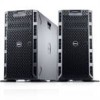Dell PowerEdge T620 Technical Guide - Page 16
Security feature, Description - systems owner s manual
 |
View all Dell PowerEdge T620 manuals
Add to My Manuals
Save this manual to your list of manuals |
Page 16 highlights
Locate reference materials, including searchable owner's manual content, LCD diagnostics, and an electrical overview Look up your service tag so you can quickly gain access to your specific hardware configuration info and warranty information Contact Dell directly (by link) to get in touch with technical support and sales teams and provide feedback to Dell These codes provide an easy way to retrieve the critical support information you need when you need it, making you more efficient and effective in managing your hardware. The PowerEdge servers have the features listed in Table 5 to help ensure the security of your data center. Security feature Cover latch Front bezel TPM Power-off security Intrusion alert Secure mode Description A tooled latch is integrated in the side cover to secure it to the rack chassis. An optional metal bezel is mounted to the chassis front to provide the Dell ID. A lock on the bezel protects un-authorized access to the hard drives and optical drive. Although the bezel has an open area to allow access to the tape backup in bay 2, the rest of the system remains locked. System status is viewable on the LCD screen when the bezel is installed. The Trusted Platform Module (TPM) is used to generate/store keys, protect/authenticate passwords, and create/store digital certificates. It also supports the Intel Xeon TXT functionality. TPM can also be used to enable the BitLocker™ hard drive encryption feature in Windows Server 2008. TPM 1.2 is supported. No TPM version is available for China or Russia. BIOS has the ability to disable the power button function. An internal switch is used to detect chassis intrusion. BIOS has the ability to enter a secure boot mode through system setup. This mode includes the option to lock out the power and NMI switches on the control panel or set up a system password.















